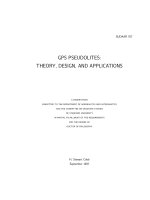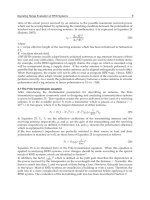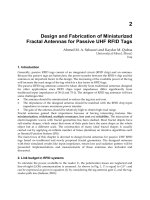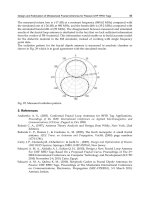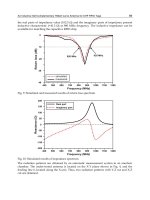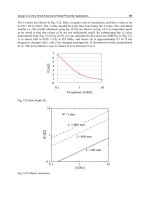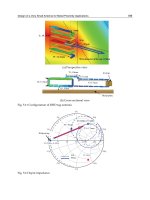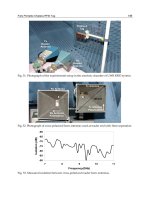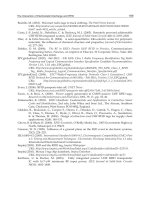GPS PSEUDOLITES : THEORY, DESIGN, AND APPLICATIONS
Bạn đang xem bản rút gọn của tài liệu. Xem và tải ngay bản đầy đủ của tài liệu tại đây (2.03 MB, 166 trang )
SUDAAR 707
GPS PSEUDOLITES:
THEORY, DESIGN, AND APPLICATIONS
A DISSERTATION
SUBMITTED TO THE DEPARTMENT OF AERONAUTICS AND ASTRONAUTICS
AND THE COMMITTEE ON GRADUATE STUDIES
OF STANFORD UNIVERSITY
IN PARTIAL FULFILLMENT OF THE REQUIREMENTS
FOR THE DEGREE OF
DOCTOR OF PHILOSOPHY
H. Stewart Cobb
September 1997
c
Copyright 1997
by
H. Stewart Cobb
ii
I certify that I have read this dissertation and that in my
opinion it is fully adequate, in scope and in quality, as a
dissertation for the degree of Doctor of Philosophy.
Bradford W. Parkinson
(Principal Advisor)
I certify that I have read this dissertation and that in my
opinion it is fully adequate, in scope and in quality, as a
dissertation for the degree of Doctor of Philosophy.
J. David Powell
I certify that I have read this dissertation and that in my
opinion it is fully adequate, in scope and in quality, as a
dissertation for the degree of Doctor of Philosophy.
Per K. Enge
Approved for the University Committee on Graduate Studies:
Dean of Graduate Studies
iii
≀
iv
Abstract
Pseudolites (ground-based pseudo-satellite transmitters) can initialize carrier-phase differ-
ential GPS (CDGPS) navigation systems in seconds to perform real-time dynamic posi-
tioning with 1σ errors as low as 1 cm. Previous CDGPS systems were rarely used due
to cumbersome initialization procedures requiring up to 30 minutes; initialization of the
carrier-phase integer ambiguities via pseudolite removes these constraints. This work de-
scribes pseudolites optimized for this application which cost two orders of magnitude less
than previous pseudolites.
Synchrolites (synchronized pseudolites), which derive their timing from individual Glo-
bal Positioning System (GPS) satellites, are also described. Synchrolites can replace the
CDGPS reference station and datalink, while simultaneously serving to initialize CDGPS
navigation. A cluster of well-placed synchrolites could enable CDGPS navigation even if
only one GPS satellite signal is available.
A prototype CDGPS system initialized by pseudolites and synchrolites was designed and
tested. The goal of this system, known as the Integrity Beacon Landing System (IBLS),
was to provide navigation accurate and reliable enough to land aircraft in bad weather.
Flight test results for prototype pseudolite and synchrolite systems, including results from
110 fully automatic landings of a Boeing 737 airliner controlled by IBLS, are presented.
Existing pseudolite applications are described, including simulation of the GPS constel-
lation for indoor navigation experiments. Synchrolite navigation algorithms are developed
and analyzed. New applications for pseudolites and synchrolites are proposed. Theoretical
and practical work on the near/far problem is presented.
v
≀
vi
Acknowledgements
This research would not have been possible without the efforts of a large number of other
people. Foremost among these is my advisor, Professor Brad Parkinson, who guided the
original development of GPS two decades ago and arranged the funding which made this
research possible. I have learned technology, leadership, and management from him. Pro-
fessor David Powell equipped his own Piper Dakota (N4341M) to support this research,
and piloted it many times for flight tests. On the ground, he taught me dynamics and
control theory. Professor Per Enge guided me through the finer points of electrical engi-
neering and estimation theory. Professors Jonathan How and Donald Cox heard, analyzed,
and approved my thesis defense. Thanks to all of these for their expertise, friendship, and
support.
The other three members of the original IBLS team were Clark Cohen, David Lawrence,
and Boris Pervan. Clark originated the IBLS concept, Boris created the integer initialization
algorithm, and Dave wrote the real-time navigation algorithm and analyzed the data. As a
team, we shared successes and setbacks, design and redesign, long discussions, long journeys,
and long hours. In the end, teamwork triumphed over all the obstacles we faced.
Other members of the GPS group donated their time and efforts to this research when-
ever necessary. Andy Barrows debugged the radio datalinks, then went to Germany as the
IBLS advance man. Gabe Elkaim proved to be an expert at both digging holes and getting
permission to dig them. Konstantin Gromov helped build modulators, interfaces, and many
other bits of hardware and software required in the course of this research. Renxin Xia de-
signed the circuitry inside the programmable logic chip that was the heart of the simple
pseudolite. Chris Shaw designed and built the weatherproof pseudolite housings and their
mounts. Todd Walter and Changdon Kee offered design ideas and advice. Jock Christie,
Mike O’Connor, Jennifer Evans, Y. C. Chao, and many others helped load, move, install,
and retrieve the mountain of equipment required for each test. To all of these, many thanks.
vii
Thanks also to Kurt Zimmerman, Paul Montgomery, Jonathan Stone, Carole Parker, and
Mike Ament for suggesting improvements to this dissertation.
The test pilots, who chose to risk their nerves and perhaps their lives advancing the state
of the art, included Keith Biehl at the FAA, Bill Loewe of United Airlines, Manfred Dieroff of
T. U. Braunschwieg, and the previously-mentioned David Powell. Steve Kalinowski, Mark
Ostendorf, Lutz Seiler, and the people of Elsinore Aerospace helped install IBLS on various
aircraft while keeping them flightworthy. Victor Wullschleger at the FAA, Gerry Aubrey of
United, and Andreas Lipp at T. U. Braunschweig arranged for their institutions to sponsor
our flight tests. Without the diligent efforts of all these people, the IBLS experiments never
would have gotten off the ground.
Flight tests cannot take place without airplanes, and airplanes cannot fly for long with-
out mechanics. Thanks to Alberto Rossi and his co-workers at PAO, the FAA’s mechanics
at ATC, the United maintenance crews at SFO, and the Aerodata team at BWE. Their
hard work kept us all safe in the air.
The GP-B office staff gave me an enormous amount of support. Denise Freeman shot
many of the photographs which appear on these pages. Sally Tsuchihashi, Mindy Lumm,
and Jennifer Gale-Messer brightened my days while keeping me in touch with the rest of
the universe.
Trimble Navigation allowed us to purchase their receivers at a discount and modify their
receiver software to track pseudolites. The FAA funded most of this research under grant
number 93G004. Earlier work was performed under NASA grant number 188N002.
Finally, I’d like to thank my family. My parents, Hank and Mary Jane, nurtured a small
spark of inquisitiveness and fanned it into a flame with toys, tools, and books. My two
brothers, Mitchell and Tucker, helped me along with fellowship, guidance, and sympathy—
or lack thereof—as necessary. I couldn’t have done this without their support. Thanks,
y’all, more than I can say.
viii
Contents
Abstract v
Acknowledgements vii
1 Introduction 1
1.1 Motivation 2
1.2 Background 4
1.3 PreviousWork 7
1.4 Contributions 9
1.5 Nomenclature 11
1.6 OutlineofthisDissertation 11
2 Pseudolite Concepts 13
2.1 Code-phaseGPSNavigation 14
2.1.1 PseudorangeMeasurements 14
2.1.2 NavigationAlgorithm 15
2.1.3 DirectRangingPseudolite 17
2.1.4 MobilePseudolite 19
2.2 DifferentialCode-phaseGPS 20
2.2.1 DigitalDatalinkPseudolite 20
2.3 Carrier-phaseDifferentialGPSNavigation 21
2.3.1 Carrier-phaseAmbiguity 22
2.3.2 CarrierphaseAmbiguityResolution 24
2.3.3 AmbiguityResolutionusingPseudolites 25
2.4 Synchrolites 28
ix
2.4.1 SynchroliteDifferentialMeasurements 30
2.4.2 SynchroliteReflectionDelay 32
2.4.3 SynchroliteDifferentialNavigation 33
2.4.4 GeometryofSynchroliteNavigation 35
2.4.5 SynchroliteNavigationwithUnknownDelays 37
2.4.6 OperationswithaSingleSynchrolite 39
2.4.7 Operations with a Single Satellite 40
3 Practical Considerations 43
3.1 GPS Satellite Signals . 43
3.1.1 C/ACodeCorrelationProperties 46
3.1.2 SignalandNoisePowerLevels 47
3.1.3 Code Division Multiple Access (CDMA) . . . 48
3.2 Near/FarProblem 49
3.3 Existing GPS Receivers . . . . . . . . . 51
3.4 Near/FarTolerance 54
3.4.1 TrajectoryConstraints 55
3.4.2 AntennaPatterns 56
3.4.3 SeparateAntennas 56
3.5 Near/FarSolutions 58
3.5.1 Out-of-BandTransmissions 58
3.5.2 FrequencyOffset 59
3.5.3 FrequencyHopping 60
3.5.4 NewSpreadingCodes 62
3.5.5 PulsedTransmissions 62
3.6 PulsedPseudoliteSignals 62
3.6.1 PulseBlanking 64
3.6.2 Receiver Saturation Characteristics . . . . . . 64
3.6.3 PulseDutyCycles 67
3.6.4 PulsePatterns 69
3.6.5 MutualInterference 71
3.7 NewSpreading(PRN)CodesforPseudolites 73
3.7.1 AdditionalC/ACodes 74
x
3.7.2 Multi-EpochC/ACodes 74
3.7.3 LongerCodes 75
3.7.4 FasterCodes 75
3.7.5 P-codes 75
3.7.6 PolyphaseCodes 76
3.7.7 AnalogCodes 76
3.8 PhaseNoise 77
3.9 Receiver Modifications 79
3.10 Recommended Receiver Improvements . 80
3.10.1 CodePhaseAiding 80
3.10.2 HighDynamicRange 80
3.11Antennas 81
3.12Legality 82
3.13Wisdom 84
4 Pseudolite Designs 87
4.1 SimplePseudolite 87
4.2 PulsedPseudolite 94
4.3 Synchrolite 95
4.3.1 AutonomousIntegrityBeacon(AIB) 96
4.3.2 AirportPseudolite(APL) 98
4.3.3 ProblemswiththeFirstSynchrolite 98
4.4 SynchroliteImprovements 99
4.5 AnalogSynchrolites 101
5 Pseudolite Flight Tests 103
5.1 IntegrityBeaconLandingSystem(IBLS) 103
5.1.1 RequiredNavigationPerformance 103
5.1.2 IBLSSystemDescription 104
5.1.3 IBLSFlightTests 106
5.2 AutonomousIntegrityBeacon(AIB) 113
5.3 PulsedSynchrolite(APL) 116
xi
6 Pseudolite Applications 121
6.1 AircraftApplications 121
6.1.1 FlightInspection 121
6.1.2 AccuracyinThirteenDimensions 122
6.2 LandApplications 124
6.2.1 RoboticTractors 124
6.2.2 Mining 125
6.2.3 Automobiles 126
6.2.4 Speculations 126
6.3 IndoorNavigation 128
6.3.1 SpaceRobotics 128
6.3.2 SpaceStructures 130
6.3.3 Speculations 130
7 Conclusions 133
7.1 ResultsandContributions 133
7.2 RecommendationsforFutureResearch 134
7.2.1 SynchroliteCDGPSReferenceStation 134
7.2.2 MultipleSynchroliteNavigation 135
7.2.3 Blanking Receivers . . . . . . . . 135
7.2.4 High Dynamic Range Receivers . 136
7.2.5 Near/FarResearch 136
7.2.6 HigherFrequencies 136
7.2.7 Applications 137
7.3 Summary 137
A Glossary 139
B Hints for Designers 143
Bibliography 145
xii
List of Figures
1.1 TheFirstSimplePseudolite 3
1.2 ApproximateAccuracyofCivilGPSNavigationModes 4
2.1 GPSNavigationusingCodePhasePseudorange 15
2.2 MobilePseudolite 19
2.3 Carrier-PhaseMeasurementsandIntegerAmbiguity 23
2.4 PseudoliteInitializesCDGPSCarrier-phaseAmbiguities 26
2.5 Synchrolite Reflects Satellite Signals Coherently . . . 29
2.6 SynchroliteDifferentialPseudorangeMeasurement 30
2.7 Synchrolite DGPS Navigation Possibilities . . . . . . 33
2.8 DGPSPositioningwithSeveralSynchrolites 34
2.9 PDOPforThreeOptimallyPlacedSynchrolites 36
2.10DGPSNavigationUsingaSingleSynchrolite 39
3.1 SpectrumofaC/ACodeSignal 45
3.2 ZonesoftheNear/FarProblem 50
3.3 SideViewofIBLSFlightPathoverPseudolite 55
3.4 ImprovingNear/FarRatiowithAntennaPatterns 57
3.5 PseudoliteSignalwithFrequencyOffset 59
3.6 MinimalInterferencefromFrequencyHoppingPseudolite 61
3.7 Pseudolite Pulses Affect Receiver AGC . 66
3.8 PseudolitePulseDutyCycleTradeoff 69
4.1 BlockDiagramoftheSimplePseudolite 88
4.2 SchematicDiagramoftheSimplePseudolite 89
4.3 AnAssembledSimplePseudolite(ActualSize) 90
xiii
4.4 TheSimplePseudoliteinOperation 91
4.5 OutputSpectrumoftheSimplePseudolite 92
4.6 HousingsfortheSimplePseudolite 93
4.7 BlockDiagramofthePulsedPseudolite 94
4.8 BlockDiagramoftheFirstSynchrolite 96
4.9 TheAutonomousIntegrityBeacon(AIB)Synchrolite 97
4.10OutputSpectrumoftheFirstSynchrolite 99
5.1 OverviewoftheIntegrityBeaconLandingSystem(IBLS) 105
5.2 IBLSFlightTestAircraft:PiperDakota 107
5.3 IBLSFlightTestAircraft:FAAKingAir 109
5.4 IBLSFlightTestAircraft:Boeing737 110
5.5 IBLSVerticalNavigationSensorError(VNSE) 111
5.6 IBLSTouchdownBox 112
5.7 LaserTrackerErrorsduringIBLSAutolandTest 113
5.8 HistogramofIntegerDifferencesduringAIBFlightTests 114
5.9 TestingtheAirportPseudolite(APL)Synchrolite 115
5.10PowerRequiredversusDistanceTransmittedforPulsedAPL 117
5.11Near/FarProblemOvercome 119
6.1 IBLSforFlightInspection 123
6.2 RoboticTractorControlledbyCDGPSwithPseudolites 125
6.3 CDGPSRoboticMiningExperiments 127
6.4 GPSRendezvousExperimentsintheAerospaceRoboticsLab 129
6.5 FlexibleSpaceStructureExperiment 131
xiv
Chapter 1
Introduction
At first glance, the concepts of time and location have nothing in common. “Where am I?”
and “What time is it?” seem to be entirely separate questions. It is motion—the change
of location over time—which links them. If you have never moved, then you know exactly
where you are. If you are moving, then your location can only be determined at a fixed
instant of time: “Where am I right now?” If your reference points are also moving, then
the accuracy of your navigation will depend on the accuracy of your clock.
John Harrison’s nautical chronometers allowed eighteenth-century sea captains to mea-
sure the motions of the stars overhead, and thereby compute longitude as well as latitude
during their journeys. Most subsequent advances in navigation, from radar to Loran to
the new Global Positioning System (GPS), have relied on advances in timekeeping. The
technology of clocks has advanced so far that, of all possible physical quantities, time is now
the one which scientists can measure most accurately. Indeed, the meter—the fundamental
unit of position—is presently defined by the distance light travels, at its unvarying speed,
during a certain interval of time. GPS turns this definition around.
The heart of the Global Positioning System is a set of 24 atomic clocks on satellites
orbiting the Earth. These clocks use nuclear physics to tell time so accurately that each
one would gain or lose scarcely a second in a million years. Each clock controls a radio
transmitter whose precisely timed signals can be heard across half the Earth’s surface. A
GPS receiver, small enough to hold in your hand, can pick up signals from several satellites.
The signals take time to travel from the satellites to your receiver, just as thunder takes
time to reach you from a distant lightning strike.
1
2 Chapter 1: Introduction
Because the satellite clocks are so accurate, the receiver knows that the signals it hears
were all transmitted at the same time. The receiver can compare the delays between the
satellite signals to compute its position anywhere on the Earth, within a margin of error
the size of a baseball field.
For navigation across the open skies or the open ocean, such accuracy is sufficient. As
you approach a runway or a harbor, though, you need more precision. At that point, your
receiver may take advantage of “differential GPS” correction signals.
The corrections come from another receiver planted at a well-surveyed location on the
ground. This receiver continuously computes the difference between its known position
and the position it gets from the satellites. It then transmits this difference, which will
be nearly identical for all nearby receivers, on a radio signal which your receiver can hear.
Your receiver can apply the correction and shrink its error down to the size of a pitchers’
mound.
Sometimes even that much error is too much. For example, an airliner landing in bad
weather needs to know its position with an error no larger than home plate. Ordinary
differential GPS cannot do this. But if a few additional GPS transmitters are placed on the
ground near the airport, the aircraft can use “carrier-phase differential GPS” to navigate
with an error the size of a baseball, all the way down to a safe landing. Those ground-
based GPS transmitters, called “pseudo-satellites” or pseudolites, are the subject of this
dissertation. Figure 1.1 shows one of the pseudolites constructed during this research.
1.1 Motivation
Modern industrial society needs increasingly accurate and reliable methods of navigation
to compensate for its decreasing tolerance of failures, delays, and costs in various systems.
For example, the “zero accidents” policy recently announced by the Federal Aviation Ad-
ministration (FAA) requires airliners to have essentially perfect navigation from takeoff to
landing. Construction workers must dig in precisely the right place, lest they cause a fire or
a widespread blackout. Modern farm machinery now varies the quantities of seed and soil
conditioner dispensed on each furrow to optimize crop yields across the entire field. The
economic success of a mine depends on the ability of its machines to locate the ore and
avoid the gangue. All these applications and more demand better navigation technology as
time goes by.
1.1: Motivation 3
Figure 1.1: The First Simple Pseudolite
Inexpensive pseudolites like this one can initialize carrier-phase differential GPS
(CDGPS) to navigate with centimeter-level accuracy.
GPS satellite navigation is a revolutionary new solution to this problem. At almost
any time, in any weather, anywhere on Earth, a receiver can tune in signals from several
orbiting satellites and compute its position with unprecedented accuracy. The 1σ accuracy
for a civilian GPS receiver, in four different modes of operation, is shown in Figure 1.2,
adapted from [2, Chapter 1].
Carrier-phase Differential GPS (CDGPS) gives the highest real-time accuracy (approx-
imately 1 cm, 1σ), but until now CDGPS has been awkward to implement in practice.
CDGPS gains its accuracy from precise measurements of fractional carrier phase, which
implies accurate knowledge of the integer number of carrier cycles as a prerequisite. Deter-
mining these integers has been a difficult and time-consuming process until now. Systems
which required the accuracy of CDGPS were forced to wait 10 minutes or more for satellite
motion to resolve the integers, or return to a precisely known location each time the system
initializes. Specialized attitude determination devices have been able to resolve integers
quickly in highly constrained systems, but no general-purpose solution has been available.
Systems which required CDGPS accuracy with rapid initialization have been forced to use
other positioning technologies such as electro-optics.
4 Chapter 1: Introduction
Horizontal
Navigation Mode
Accuracy (1σ)
Standalone GPS (w/SA) 40 meters
Wide-Area Differential GPS 3 meters
Local Area Differential GPS 1 meter
Carrier-phase Differential GPS 0.01 meters
Figure 1.2: Approximate Accuracy of Civil GPS Navigation Modes
By reducing the time needed to determine the carrier-phase integers, and the cost of this
reduction, by two orders of magnitude each, the work presented in this dissertation makes
CDGPS navigation much more widely available. Any application which requires real-time
navigation, with centimeter-level accuracy, in a defined space less than 10 kilometers or so
across, can now meet its needs using CDGPS and the simple pseudolites described in this
dissertation.
Synchronized pseudolites or synchrolites, also described here, simplify CDGPS systems
even further. A synchrolite can be imagined as an electronic mirror which “reflects” GPS
satellite signals from a known point on the ground. A synchrolite can serve as a CDGPS
reference station as well as an initialization device, thus eliminating the need for a separate
differential reference station and associated datalink. By reducing the latency of the ref-
erence transmission from seconds to milliseconds, synchrolites increase the allowable band-
width of position feedback loops in automatic control systems, while virtually eliminating
the effects of selective availability (SA) clock dithering.
1.2 Background
This section provides only a brief overview of GPS concepts. A thorough description of
GPS techniques and applications is available in a recent two-volume set [1, 2] known as the
“blue books.” Articles from the journal Navigation concerning GPS are collected in four
volumes [3, 4, 5, 6] known as the “red books.” The actual government specification for the
GPS signal format is known as ICD–200 [7].
Code-Phase GPS Navigation Each GPS satellite transmits a signal composed of a pre-
dictable noise-like digital code (known as a Gold code) modulated on a microwave carrier
1.2: Background 5
frequency (known as L1). The timing of the code and carrier signals is precisely controlled
by an atomic clock aboard the satellite. A GPS receiver can tune in a satellite signal by
generating a private copy of the Gold code and carrier and matching their timing to the
incoming signal. The Gold codes are designed so that a GPS receiver can tune in several
signals at once.
The signal travels from the satellite to the receiver at the speed of light, causing a delay
of about 70 milliseconds. The exact value of the delay depends on the exact distance from
the satellite to the receiver, which is constantly changing. The receiver compares the delays
from four separate satellite signals in a triangulation algorithm to compute its position.
Most receivers measure the delay of a signal by examining the timing of its digital Gold
code (known as the code phase). The Gold code bits (known as chips) are transmitted at a
1.023 MHz rate, so that each chip is about 293 meters long. Receivers can measure the delay
of a strong signal to within a fraction of a percent of the chip length, or about 0.5 meters.
This limits the accuracy of code-phase GPS navigation, regardless of other errors.
Differential GPS The satellite signal delays measured by a receiver include errors due to
many factors. Some of these are: satellite clock errors, satellite position errors, variations in
the density of the ionosphere and troposphere, and “multipath” reflections from objects near
the receiver. The effects of these errors combine to produce position errors of approximately
10 meters (horizontal, 1σ). As of this writing, the satellite clock errors have been artificially
increased to produce position errors of approximately 41 meters (horizontal, 1σ) [1, Chapter
11]. These deliberately imposed clock errors implement a government policy known as
selective availability or SA.
Most of the errors listed in the previous paragraph are common to all receivers within
hundreds of kilometers. A GPS receiver fixed in a well-known location can measure these
errors, correct for them, and broadcast the corrections to other nearby receivers. This
technique is called differential GPS or DGPS. Using code-phase GPS navigation with dif-
ferential GPS corrections, mobile receivers can reduce their position errors to approximately
2.2 meters (horizontal, 1σ)[2,Chapter1].
Carrier-Phase Differential GPS When more accuracy is required, some GPS receivers can
measure delays using the satellite signal’s carrier wave as well as the Gold code. Cycles of
the carrier wave are only about 19 centimeters long. A receiver can measure carrier phase
6 Chapter 1: Introduction
(fractions of a cycle) to within a fraction of a percent, or 1 mm. But while the Gold codes
are designed so that each chip is distinct, each carrier cycle is identical to the next. The
receiver can directly measure the fraction of a carrier cycle, but the number of whole cycles
(known as the integer ambiguity) must be derived indirectly.
It is impractical to attempt to measure the delay, in cycles, from a satellite to a receiver.
Instead, a nearby fixed GPS receiver takes carrier phase measurements and transmits them
to nearby user receivers. This is known as carrier-phase differential GPS or CDGPS. The
integer ambiguities then describe the number of whole cycles between the fixed receiver and
a mobile user receiver. Once the integer ambiguities are resolved, the mobile receiver can
compute its position relative to the fixed receiver with centimeter-level accuracy [2, Chapter
15].
Ambiguity Resolution Methods Several methods for resolving the integer ambiguities
have been developed. Most take 10 minutes or more, either to collect and filter data or to
allow the satellites to move in the sky. The only reliable faster method, until now, was to
place the mobile receiver in a known position (with centimeter accuracy) while initializing
the integer ambiguities to pre-computed data. None of these methods is convenient for
situations such as aircraft on final approach to landing.
Pseudolites installed at known locations provide a fast, accurate means to initialize the
integer ambiguities for moving vehicles using CDGPS navigation. As the vehicle moves
past the pseudolites, it collects geometric information which allows it to resolve the integer
ambiguities with a high probability of success and an extremely low (10
−9
) probability of
undetected failure.
Near/Far Problem As the vehicle approaches a pseudolite, the signal it receives from that
pseudolite grows stronger. In fact, the pseudolite’s signal can become so strong that it jams
the relatively weak signals from distant GPS satellites. This phenomenon is known as the
“near/far problem.” In the past, this problem severely constrained the use of pseudolites,
but new techniques such as pulsed transmissions can virtually eliminate this constraint.
Any vehicle which requires centimeter-accurate navigation within a sphere of 20 km
radius or less can now achieve it using CDGPS navigation assisted by pseudolites. The
distance constraint is not severe; even transcontinental aircraft require this level of accuracy
1.3: Previous Work 7
only near airports. The simple, inexpensive pseudolites described in this dissertation remove
the last barrier to the widespread use of CDGPS navigation.
1.3 Previous Work
The pseudolite concept is older than the GPS system itself. Before the first GPS satellites
were launched, the GPS concept was tested with pseudolites mounted on high mesas at a
desert test range [8]. Pseudolites have returned to the literature periodically ever since.
This section will provide an overview of previous work in pseudolites, although detailed
explanations of some concepts will be deferred to the next chapter.
Klein and Parkinson [9] were the first to point out that pseudolites could be a useful
adjunct to the operational GPS system, improving navigation availability and geometry
for critical applications such as aviation. This pioneering paper also describes the near/far
problem and presents several alternative solutions, including the option of transmitting the
pseudolite signal in short pulses. One of these pulsing schemes was implemented almost
identically in several pseudolites constructed during the present research.
Parkinson and Fitzgibbon [10] developed and demonstrated a procedure for finding the
optimal location for a ranging pseudolite. The locations were optimum in the sense that
navigation accuracy was maximized (DOP minimized) after the worst-case single satellite
failure.
The RTCM-104 committee, which developed the first standard for local area DGPS
systems[11], simultaneously proposed a method for transmitting DGPS information by pseu-
dolite [12]. This proposal included a detailed specification for a pulsed transmission scheme.
The RTCM-104 pulsing scheme was also implemented almost identically during the course
of this research.
A.J. van Dierendonck has been by far the most prolific writer on pseudolites. Beginning
in the late 1980’s, he wrote a number of papers describing various applications of pseu-
dolites. One paper [13] suggested improvements to the RTCM-104 standard, including a
different pulsing pattern and a 30 kHz frequency offset to minimize periods of worst-case in-
terference with satellite signals. Another paper [14] proposed yet another pulse pattern and
an extended-length pseudorandom code. A third paper [15] proposed pulsed P-code pseu-
dolites transmitting on the L2 frequency as a navigation aid for naval aviation. A similar
concept was later proposed by Kovach and Fernandez [16], using the encrypted Y-code.
8 Chapter 1: Introduction
More recently, van Dierendonck worked with Bryant Elrod’s group at Stanford Telecom
to flight-test pseudolites for aviation applications [17, 18]. These pseudolites transmit in
pulses at a carrier frequency offset by exactly 1.023 MHz (the C/A code chip rate) from the
L1 frequency. Although this offset was expected to virtually eliminate interference with the
satellite signals, Gary McGraw at Rockwell later showed that the reduction in worst-case
cross-correlation is only 3.6 dB [19].
Stanford Telecom reportedly built a set of pulsed pseudolites for tests performed by the
Strategic Defense Initiative, circa 1990. A paper presented at the ION-GPS-90 conference
[20] is cited in another paper presented at the same conference [15], but the first paper does
not actually appear in the conference proceedings. This paper apparently described further
progress on the project described in [21]. Other references to this work are found in [2,
pages 52 and 612].
Alison Brown and her team at Navsys carried out flight tests of approach navigation
using a pseudolite and a modified GPS receiver [22, 23]. They evaded the near/far problem
by transmitting their pseudolite signal in an aeronautical communications band separated
by many tens of MHz from the GPS L1 and L2 frequencies. Obviously, this required a
non-standard receiver with more than one RF signal path.
Awele Ndili at Stanford University has researched new families of pseudorandom codes
for use by pseudolites [24]. These new codes cause less interference with the satellite codes
than the existing pseudolite Gold codes cause.
Most recently, a team at Holloman Air Force Base has developed an inverted GPS
system using a mobile pseudolite and fixed receivers [25]. Tests of this system avoided the
near/far problem by maintaining a relatively constant distance between the pseudolite and
the receivers.
The state of the pseudolite art, except for the present research, was summarized by
Elrod and van Dierendonck in 1995 [2, Chapter 2].
The CDGPS technique has a long and fruitful history. It is the basis for GPS survey
systems, which were the first commercial market for GPS. The original “static” survey
systems computed angles and distances between fixed points. More recently, “kinematic”
surveying techniques have been developed, which track the movement of a mobile receiver
relative to a fixed base. These techniques are described in Goad [2, Chapter 18], Remondi
[26, 27], and Cannon [28]. With the exception of the present research, the use of pseudolites
1.4: Contributions 9
for carrier-phase ambiguity resolution in CDGPS navigation has not been considered in the
literature.
1.4 Contributions
The initial goal of this research was to deduce and demonstrate an optimized design for
pseudolites used to initialize CDGPS navigation systems. In the course of this research,
it was discovered that no single optimum exists; instead, the optimum pseudolite design
depends on the requirements of the overall system. This dissertation presents several pseu-
dolite designs optimized for different conditions. One of these designs was tested in a
prototype pseudolite-assisted CDGPS system; results from extensive testing under realistic
conditions are presented. In addition, this dissertation describes, as completely as possible,
the requirements and tradeoffs which future pseudolite designers must consider.
Taken together, these contributions remove time and cost constraints which previously
prevented the widespread use of CDGPS navigation. Applications which require centimeter-
level accuracy and high integrity in real-time positioning can now achieve these goals with
CDGPS and pseudolites like those described here.
The specific contributions of this research are the following:
1. Simple Pseudolites The first pseudolites optimized for CDGPS initialization at mini-
mum cost were designed, constructed, and tested. These pseudolites cost approximately two
orders of magnitude less than previous pseudolites (roughly $1000 versus $100,000). These
inexpensive pseudolites accurately initialized CDGPS navigation systems to centimeter-level
accuracy every time they were tested.
An additional application of these simple pseudolites was discovered by several Stanford
researchers who successfully used sets of them to simulate the GPS satellite constellation
during indoor experiments. Previous pseudolites were prohibitively expensive for this ap-
plication.
2. Integrity Beacon Landing System The first centimeter-accurate CDGPS navigation
system initialized by pseudolites was designed, developed, and demonstrated. This research,
in conjunction with the research of David Lawrence [29] and Boris Pervan [30], produced a
prototype CDGPS system known as the Integrity Beacon Landing System (IBLS). Flight
10 Chapter 1: Introduction
tests of IBLS demonstrated the feasibility of using pseudolites to initialize CDGPS position-
ing in a real-world application with highly stringent requirements. The Integrity Beacon
pseudolites initialized IBLS within 15 seconds to navigate with 1 cm (estimated) accuracy
and “nine nines” integrity. Initialization time was improved by two orders of magnitude
over previous CDGPS methods.
This dissertation documents the pseudolites required for the IBLS research project,
as well as other pseudolites and their applications. Boris Pervan’s dissertation [30] doc-
uments the algorithm used to initialize CDGPS positioning from the pseudolite data and
the resulting navigation integrity. David Lawrence’s dissertation documents the real-time
CDGPS positioning algorithm selected and its actual performance during these tests. The
cooperative IBLS research is fully described by these three dissertations.
3. Synchrolites The first synchrolite (a contraction of “synchronized pseudolite”) was de-
signed, constructed, and tested. Flight tests of IBLS showed that the synchrolite (used as an
Autonomous Integrity Beacon) accurately initialized CDGPS navigation without requiring
a connection from the pseudolite to the CDGPS reference station. One future synchrolite
can serve a CDGPS navigation system as both reference station and initializer. A cluster
of synchrolites and pseudolites can provide a backup for GPS satellites, allowing naviga-
tion even if the satellite constellation fails. These applications, and designs for improved
synchrolites which can support them, are described.
4. Pulsed Pseudolites The first published tests of a pulsed pseudolite on the L1 frequency
were conducted, achieving a near/far range ratio greater than 10
5
. The first data transmis-
sion through a pulsed pseudolite was acheived, and successful data transmission at 50 bps
was demonstrated throughout the near/far tests.
5. Design Rules and Trades This dissertation presents a comprehensive discussion of the
issues involved in pseudolite system design. Near/far constraints for non-pulsed pseudolites
and various classes of receivers are examined. Tradeoffs among possible solutions to the
near/far problem are discussed, based on the capabilities of present and near-future system
components. Receiver design considerations for pseudolite compatibility are presented.
1.5: Nomenclature 11
1.5 Nomenclature
This dissertation necessarily contains terms and abbreviations from electrical engineering
which may be unfamiliar to aerospace engineers. To minimize both confusion and repetition,
a glossary of terms and acronyms has been provided in Appendix A.
The technology of pseudolites and related systems has evolved rapidly during the last
few years. One unfortunate result is that the nomenclature for these systems has also
evolved. In general, the terminology used in older references differs from the terminology
in this thesis. The same things are described in different words.
The “simple pseudolite” described herein was originally called a “GPS Doppler Marker.”
It was also known for a time as an “Integrity Beacon” due to its initial application in the
Interity Beacon Landing System. Since then, the term “Integrity Beacon” has become a
category, covering every pseudolite ever used in an IBLS system, not just this particular
model. The name “Airport Pseudolite,” abbreviated APL, applies to any long-range pseu-
dolite, regardless of hardware, installed on airport property to provide the benefits described
in Section 5.3.
The “Synchrolite,” or synchronized pseudolite, described herein was originally known
as an “Omni-Marker”. It, too, is more a concept than a specific piece of hardware. A
synchrolite with two transmitters, installed to function as Integrity Beacons, has been called
an “Autonomous Integrity Beacon” or AIB.
In the course of this research, a pair of simple pseudolites was tested as Integrity Beacons,
another pair of (modified) simple pseudolites was tested as APL’s, and a Synchrolite was
tested as both an AIB and an APL. Chapter 4 discusses the designs of all these devices;
Chapter 5 describes the tests.
1.6 Outline of this Dissertation
This dissertation begins with the theory of GPS pseudolites. Chapter 2 describes the
various types of pseudolites at the conceptual level. Chapter 3 discusses the major practical
problems in pseudolite system engineering, along with some possible solutions. Chapter 4
describes in some detail the designs of several pseudolites which were actually constructed
and tested in the course of this research. The remaining chapters present applications
of pseudolites to real-world problems. Chapter 5 concentrates on aircraft navigation for
precision approach and landing, including results of flight tests of some proof-of-concept

